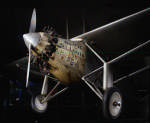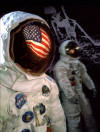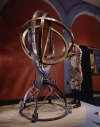

The National Air and Space Museum on the National Mall in Washington, D.C.
has hundreds of original, historic artifacts on display, including the Wright 1903 Flyer;
the Spirit of St. Louis; the Apollo 11 command module Columbia; and a Lunar rock sample
that visitors can touch.
 A front view of the Ryan NYP Spirit of St. Louis, the aircraft flown by Charles Lindbergh solo across the Atlantic in 1927. A front view of the Ryan NYP Spirit of St. Louis, the aircraft flown by Charles Lindbergh solo across the Atlantic in 1927.
The Museum offers 22 exhibition galleries, the Lockheed Martin Imax
Theater, flight simulators, a three-level Museum shop, and a food-court-style restaurant.
Docent tours, daily free educational programs, and school group tours and activities are also
available.
A dramatic re-creation of the meteorite impact that hastened the end of the Age of Dinosaurs 65 million years ago is a highlight of the planetarium show "Cosmic Collisions."
The Albert Einstein Planetarium presents two shows daily: Cosmic Collisions
launches visitors on a thrilling trip through space in a spectacular immersive theater experience. The Stars Tonight offers a relaxing journey through the current night sky. (Varying schedules.)
A favorite gallery for children is How Things Fly - the place for hands-on action
including fascinating science demonstrations; paper airplane contests; and 50 exciting interactive
devices.
Experience the early history of the airplane - from some of the earliest notions
of flying through the first decade of powered flight - in the Early Flight gallery.
Visitors can get a close-up view of the original 1903
Wright Flyer and 170 other related artifacts in The
Wright Brothers & The Invention of the Aerial Age. After the
exhibition closes, the Flyer will be returned to its usual hanging position
in the Milestones of Flight
gallery.
The history of human space exploration is detailed in two exhibitions. To learn
about the American and Soviet competition, visit Space Race, where artifacts on display include the
V2 ballistic missile, a full-size Hubble Space Telescope test vehicle, and the backup Skylab space
station that visitors can walk through.
 The space suits worn by Buzz Aldrin and Neil Armstrong on the Moon.
The space suits worn by Buzz Aldrin and Neil Armstrong on the Moon. |
The story of America's effort to land a human on the Moon is told in Apollo to the Moon,
where the original space suits worn by Neil Armstrong and Buzz Aldrin on the Moon are on display.
The Museum on the National Mall also features several exhibitions covering Earth and planetary
studies. Looking at Earth shows visitors how views of our planet from above have helped us to better understand
the Earth. Examples of satellite imagery and aerial photography are on display.
Exploring the Planets highlights the history and achievements of planetary explorations,
both Earth-based and by spacecraft. On display here is a full-scale replica of the Voyager spacecraft which
traveled to the outer planets: Jupiter, Saturn, Uranus, and Neptune.
Explore the Universe demonstrates the various methods used by humankind to observe the skies
throughout the ages, starting with the naked eye, through telescopes, and finally into the digital age.
 A view of the Tycho Armillary Sphere reproduction on display in Explore the Universe. The Sphere was built by Danish astronomer Tycho Brahe in the late 1500s to study the sky and to teach about the celestial coordinate system. A view of the Tycho Armillary Sphere reproduction on display in Explore the Universe. The Sphere was built by Danish astronomer Tycho Brahe in the late 1500s to study the sky and to teach about the celestial coordinate system.
For details about the many other exhibits at the Museum, click here.
In 2001, the National Air and Space Museum celebrated its 25th anniversary. See the Timeline for
a chronology of all major events in the Museum's history. For more facts and figures about the downtown museum,
please see the Museum's press kit; for a complete list of the Museum's exhibitions, please see the Exhibitions page.
Begin planning your visit to the Museum on the National Mall, or learn about the National Air and Space
Museum's two other sites by selecting from the menu on the left.
The Museum benefits from the guidance received from the distinguished Americans on the National Air and Space Museum Board.
|